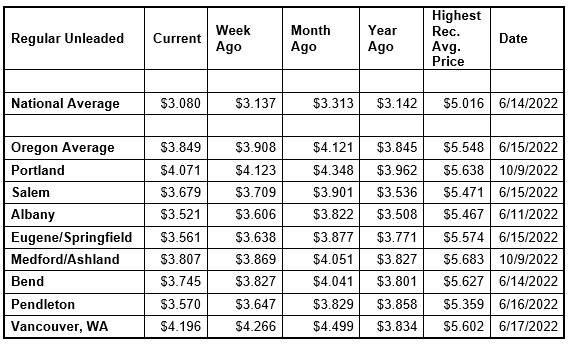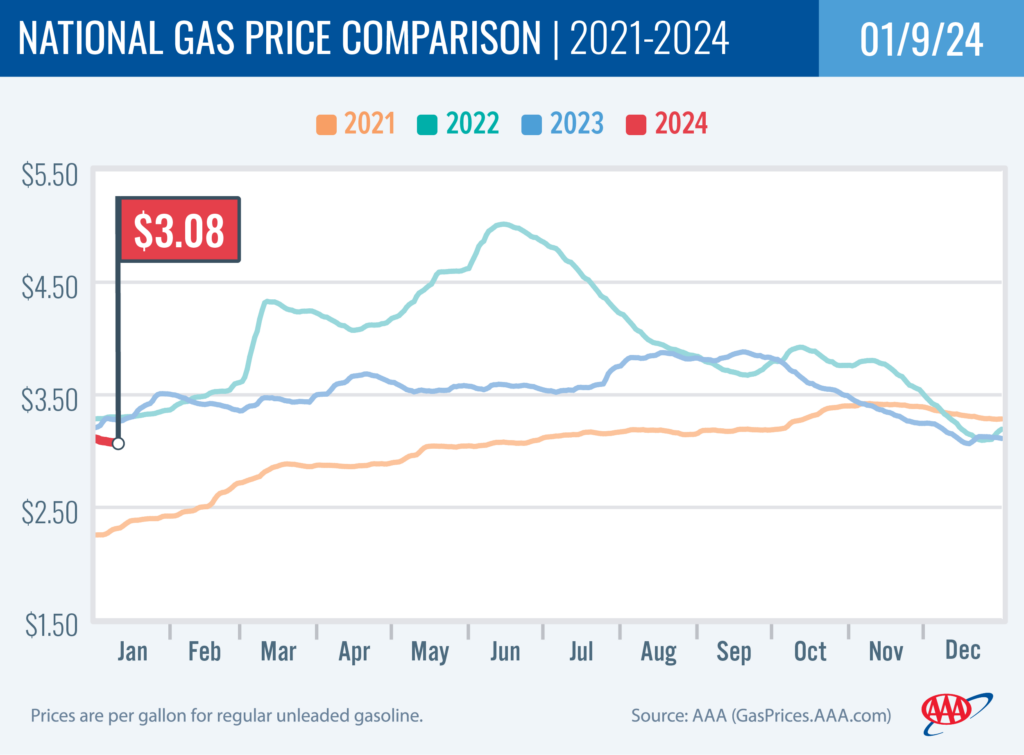PORTLAND, Ore., – Gas prices are ticking down as 2024 begins and are similar to prices at the start of 2023. Most states, including Oregon, are seeing week-over-week declines. Demand for gas has nosedived, putting downward pressure on pump prices. For the week, the national average for regular slips three cents to $3.08 a gallon. The Oregon average falls eight cents to $3.72.

“We normally see demand for gas fall after the holiday travel period, and that’s the case this year. Winter weather across the country – including atmospheric rivers and snowstorms – means more people are staying home. The drop in demand along with an increase in gasoline supplies is leading to decreases at the pumps,” says Marie Dodds, public affairs director for AAA Oregon/Idaho. “Barring some unexpected events that impact global crude oil prices, gas prices will likely continue to tick up or down a few cents in the short term, depending on crude oil prices. Pump prices often start to increase again in the first quarter.”
The national average is at its lowest price since June 2021. The Oregon average is at its lowest price since January 2023.
The average price of regular gas nationally in 2023 was $3.53 a gallon, which is the third-most expensive year ever. 2022 was the most expensive with an average of $3.96 a gallon. 2012 is second with an average price of $3.60 a gallon. The high price for 2023 was $3.88 on September 18. The low price for 2023 was just under $3.07 on December 18.
The average price for regular gas in Oregon in 2023 was $4.23 a gallon. The high price for the year was $4.77 on August 30. The low price for 2023 was just under $3.69 on January 14.
The average price for regular gas in Washington in 2023 was $4.58. The high price for 2023 was $5.13 on September 30. The low price for the year was just under $3.84 on January 1.
Most Oregon counties have averages below $4 a gallon. The only counties with averages at or above $4 are:
Coos $4.02
Curry $4.34
Multnomah $4.06
Sherman $4.09
Gas prices normally rise in the first and/or second quarters of the year. The factors include refinery maintenance season, the normal seasonal growth in demand, and the switch from winter-blend fuel to summer-blend, which is more expensive to produce. Summer-blend gas helps reduce emissions from gasoline during the warm summer months. More info on summer- and winter-blend gasoline can be found at the EPA website.
Crude oil prices continue to be volatile on concerns surrounding mounting geopolitical tensions in the Middle East after attacks on commercial vessels in the Red Sea. The conflict between Israel and Hamas has led to additional violence in the West Bank, Lebanon, Syria and Iraq. While Israel and the Palestinian territory are not oil producers, there’ve been concerns that the conflict could spread in the Middle East, which could potentially impact crude production in other oil-producing nations in the region.
Crude oil is trading around $73 today compared to $70 a week ago and $75 a year ago. In 2023, West Texas Intermediate ranged between $63 and $95 per barrel. Crude reached recent highs of $123.70 on March 8, 2022, shortly after the Russian invasion of Ukraine, and $122.11 per barrel on June 8, 2022. The all-time high for WTI crude oil is $147.27 in July 2008.
Crude oil is the main ingredient in gasoline and diesel, so pump prices are impacted by crude prices on the global markets. On average, about 57% of what we pay for in a gallon of gasoline is for the price of crude oil, 7% is refining, 22% distribution and marketing, and 14% are taxes, according to the U.S. Energy Information Administration.
Demand for gas in the U.S. has plummeted from 9.17 to 7.95 million b/d for the week ending December 29, according to the U.S. Energy Information Administration (EIA). This compares to 7.51 million b/d at the same time last year. Meanwhile, total domestic gasoline stocks increased substantially by 10.9 million bbl to 237 million bbl.
Weak gas demand, alongside increased supply, has pushed pump prices lower. However, volatile crude oil prices may limit gas price decreases. If gas demand remains weak, drivers will likely continue to see pump prices trickle downward.
Quick stats
Oregon is one of 42 states and the District of Columbia with lower prices now than a week ago. Arizona (-12 cents has the biggest weekly drop. Florida (+9 cents) has the largest week-over-week increase.
Hawaii ($4.67) has the most expensive gas in the nation. California ($4.66) is second, and Washington ($4.07) is third. These are the three states with averages at or above $4, same as a week ago. This week 17 states and the District of Columbia have averages in the $3-range. Thirty states have averages in the $2 range this week.
The cheapest gas in the nation is in Oklahoma ($2.58) and Wisconsin ($2.62). No state has had an average below $2 a gallon since January 7, 2021, when Mississippi and Texas were below that threshold.
The difference between the most expensive and least expensive states is $2.09 this week, compared to $2.00 a week ago.
Oregon is one of 48 states and the District of Columbia with lower prices now than a month ago. The national average is nine cents less and the Oregon average is 21 cents less than a month ago. Idaho (-35 cents) has the largest monthly drop. Florida (+13 cents) and Texas (+4 cents) are the only states with month-over-month increases.
Oregon is one of only five states with higher prices now than a year ago. The national average is 20 cents less and the Oregon average is one cent more than a year ago. Ohio (-55 cents) has the largest yearly decrease. California (+23 cents) has the largest yearly increase.
West Coast
The West Coast region continues to have the most expensive pump prices in the nation with all seven states in the top 10. It’s typical for the West Coast to have six or seven states in the top 10 as this region tends to consistently have fairly tight supplies, consuming about as much gasoline as is produced. In addition, this region is located relatively far from parts of the country where oil drilling, production and refining occurs, so transportation costs are higher. And environmental programs in this region add to the cost of production, storage and distribution.
As mentioned above, Hawaii has the most expensive gas in the country. California, Washington, Nevada, Oregon, and Alaska rounding out the top six. Arizona is ninth. Oregon is fifth most expensive for the 12th week in a row.
Like most every other state in the nation, six of the seven states in the West Coast region are seeing week-over-week declines. Arizona (-13 cents) has the largest weekly drop in the nation and the region. Oregon (-8 cents), California (-5 cents), Washington (-5 cents), Nevada (-4 cents), and Alaska (-3 cents). Hawaii (+3/10ths of a cent) is the only state in the region with a weekly increase.
The refinery utilization rate on the West Coast rose from 86.9% to 88.4% for the week ending December 29. This rate has ranged between about 73% to 96% in the last year. The latest national refinery utilization rate is up slightly from 93.3% to 93.5%.
According to EIA’s latest weekly report, total gas stocks in the region increased from 27.15 million bbl.to 28.88 million bbl.
A higher refinery utilization rate and an increase in gasoline stocks can put downward pressure on pump prices.
Oil market dynamics
Crude oil prices declined to start this week after Saudi Arabia cut its official price for its flagship crude oil product, Arab Light Crude, for its Asian customers. The move may be because Saudi Arabia sees lower demand for crude oil, or the kingdom could be trying to counter increased oil production in North America. Crude prices increased last week amid heightened tensions in the Middle East. Shipping disruptions in the Red Sea and the potential for tighter sanctions on Iran led to market concerns that the oil supply could tighten and transportation costs could rise. Additionally, the EIA reported that total domestic commercial crude inventories declined by 5.5 million bbl to 431.1 million bbl last week.
At the close of Friday’s formal trading session, WTI added $1.62 to settle at $73.81. At the close of Monday’s formal trading session, WTI fell $3.04 to settle at $70.77. Today crude is trading around $72 compared to $70 a week ago. Crude prices are about $3 lower than a year ago.
Drivers can find current gas prices along their route with the free AAA Mobile app for iPhone, iPad and Android. The app can also be used to map a route, find discounts, book a hotel and access AAA roadside assistance. Learn more at AAA.com/mobile.

Diesel
For the week, the national average dips three cents to $3.95 a gallon. The record high is $5.816 set on June 19, 2022. The Oregon average falls seven cents to $4.29. The record high is $6.47 set on July 3, 2022. A year ago the national average for diesel was $4.65 and the Oregon average was $4.77.
Find current fuel prices at GasPrices.AAA.com.
AAA news releases, high resolution images, broadcast-quality video, fact sheets and podcasts are available on the AAA NewsRoom at NewsRoom.AAA.com.
Find local news releases at https://oregon.aaa.com/community/media/media-contacts.html
Fuel prices are updated daily at AAA’s Daily Fuel Gauge at AAA Gas Prices. For more info go www.AAA.com. AAA Oregon/Idaho provides more than 895,000 members with travel, insurance, financial and automotive-related services, and is an affiliate of AAA National, serving more than 64 million motorists in North America.

